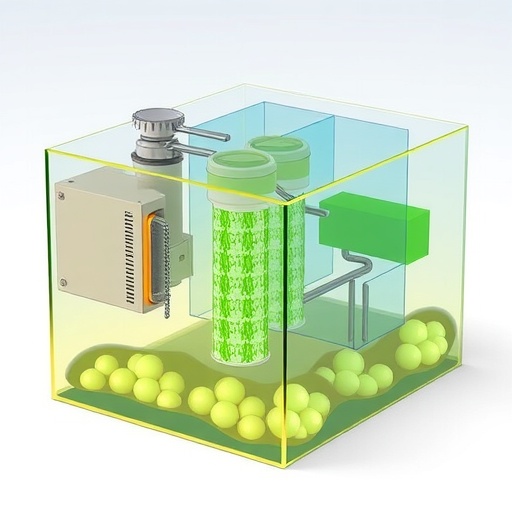In an era where agricultural practices are under scrutiny for their environmental impact, a groundbreaking study published in “Ionics” has shed light on a novel approach to mitigate one of the persistent pollutants affecting water quality—3-methyl-4-nitrophenol (MNP). This compound, a by-product of pesticide manufacturing, poses serious risks to not only aquatic ecosystems but also human health when it contaminates water resources used for irrigation. Researchers, led by JP.T. Silga and colleagues, have embarked on an innovative solution that combines nanofiltration technology with a microbial fuel cell utilizing Trichoderma harzianum, a fungus known for its environmental applications.
The significance of the research lies in its dual-focus strategy: not only reducing the concentration of MNP in contaminated water but also harnessing microbial energy in the process. The combination of nanofiltration, a membrane filtration process that separates particles based on size and charge, with bioelectrochemical systems enhances the removal efficiency of this hazardous chemical. The study details a methodology that could revolutionize how we manage pollutants in agricultural irrigation systems.
Nanofiltration works effectively in separating small molecules, which makes it a suitable candidate for removing pesticide by-products. The adoption of this technology addresses the urgent need for purification systems capable of handling complex mixtures often found in agricultural runoff. The researchers demonstrated that the nanofiltration membranes used in their experiments successfully filtered out MNP, significantly reducing its concentration in the water samples tested. This marks a substantial advancement in our toolkit for combating agricultural pollution.
In parallel to the nanofiltration efforts, the utilization of Trichoderma harzianum within a microbial fuel cell offers a sustainable energy recovery option. This filamentous fungus is known not only for its biocontrol properties in agriculture but also for its ability to thrive in wastewater conditions. The research team effectively integrated the fungus into a microbial fuel cell setup, allowing it to leverage the organic matter present in the water as a substrate for microbial activity while simultaneously facilitating the breakdown of pollutants.
The study showcases that this combined approach could lead to a win-win situation. While MNP is effectively removed from water, the microbial fuel cell generates electricity as a by-product of the biological processes involved. The output energy could potentially power small-scale irrigation systems or be fed back into the grid, providing an additional economic incentive for farmers and agricultural stakeholders. This innovative intersection of wastewater treatment and renewable energy production could transform agricultural practices, particularly in regions heavily reliant on chemical fertilizers and pesticides.
The results from Silga et al. demonstrate improved removal efficiencies that are not only impressive but also indicative of the promising outlook for this technology in practical applications. Their experiments revealed that the combined approach of nanofiltration followed by microbial treatment could achieve up to 90% reduction in MNP concentrations. This success paves the way for further enhancements, particularly regarding optimizing operational conditions for maximized pollutant degradation.
Moreover, the research holds vital implications for policy formulations, particularly in terms of water management regulations in the agricultural sector. As concerns over food safety and environmental sustainability mount, technologies like the one developed by Silga and his team could provide viable routes to comply with stringent water quality standards. Farmers and policymakers alike could potentially leverage this technology in tandem with existing agricultural frameworks, leading to a more sustainable future.
Another vital aspect of the study rests on the environmental impact assessment of deploying such technologies. The researchers have initiated discussions around lifecycle analyses of the proposed system, which examines the net environmental benefits against the operational costs and energy usage of nanofiltration and microbial fuel cells. The upfront investment in developing these purification systems could be offset by reduced health risks and the restoration of polluted water bodies, illustrating conservation economics at play.
In light of increasing population pressures and corresponding agricultural demands, the urgency of addressing pollutants like MNP cannot be overstated. This study represents a crucial step towards establishing a more integrated approach to water management and agricultural practice, whereby ecological balance is maintained even amidst the challenges posed by chemical residues. Through research such as this, we inch closer to achieving a sustainable agricultural landscape that prioritizes both productivity and environmental stewardship.
As agricultural practices continue to evolve, the collaboration between biotechnology, engineering, and environmental science becomes increasingly significant. The work done in this study corroborates the hypothesis that innovative technologies can intersect to tackle complex environmental challenges. The multidisciplinary approach exemplified here not only underscores the importance of collaboration among various scientific domains but also lays out a framework for future studies addressing similar agricultural pollutants.
Challenges do remain, particularly regarding scalability and the readiness of farmers to adopt new technologies. Education and training will be paramount to ensuring farmers can not only implement these systems successfully but also maintain them effectively over time. The potential for this research to bridge the gap between cutting-edge science and practical agricultural applications cannot be understated—a well-informed community equipped with new tools can make big strides toward mitigating water pollution on a larger scale.
Conclusively, Silga and his team’s research presents an innovative leap forward in the fight against agricultural contaminants. Not only does it contribute to scientific literature regarding MNP removal, but it also opens doors for real-world applications that intersect wastewater treatment and renewable energy. Their findings will undoubtedly inspire future research and initiatives aimed at fostering responsible and sustainable agricultural practices throughout the globe.
Subject of Research: Removal of 3-methyl-4-nitrophenol from water using nanofiltration combined with Trichoderma harzianum microbial fuel cell for irrigation purposes.
Article Title: Evaluation of 3-methyl-4-nitrophenol a pesticide by-product removal from water using nanofiltration combined by Trichoderma harzianum microbial fuel cell for irrigation purposes.
Article References:
Silga, JP.T., Bako, Y.F.R., Kalboussi, N. et al. Evaluation of 3-methyl-4-nitrophenol a pesticide by-product removal from water using nanofiltration combined by Trichoderma harzianum microbial fuel cell for irrigation purposes.
Ionics (2025). https://doi.org/10.1007/s11581-025-06613-6
Image Credits: AI Generated
DOI: https://doi.org/10.1007/s11581-025-06613-6
Keywords: 3-methyl-4-nitrophenol, nanofiltration, Trichoderma harzianum, microbial fuel cells, water purification, sustainable agriculture.




